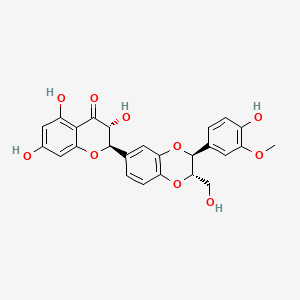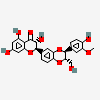Silibinin B
- Silybin B
- Silibinin B
- 142797-34-0
- SILYMARIN
- SILYBIN (A and B)(P)
- Create:2005-07-11
- Modify:2025-01-18

- 2,3 Dehydrosilybin
- 2,3-dehydrosilybin
- Alepa forte
- Alepa-forte
- Ardeyhepan
- Cefasilymarin
- durasilymarin
- Hepa loges
- Hepa Merz Sil
- hepa-loges
- Hepa-Merz Sil
- HepaBesch
- Hepar Pasc
- Hepar-Pasc
- Heparsyx
- Heplant
- Lagosa
- legalon forte
- silibin
- silibinin
- Silibinin A
- Silibinin B
- silybin
- silybin A
- silybin B
- silybinin
- Silybin B
- Silibinin B
- 142797-34-0
- SILYMARIN
- SILYBIN (A and B)(P)
- UNII-853OHH1429
- 65666-07-1
- (2R,3R)-3,5,7-trihydroxy-2-[(2S,3S)-3-(4-hydroxy-3-methoxyphenyl)-2-(hydroxymethyl)-2,3-dihydro-1,4-benzodioxin-6-yl]-2,3-dihydrochromen-4-one
- Legalon
- DTXSID30858697
- 853OHH1429
- (2R,3R)-3,5,7-trihydroxy-2-((2S,3S)-3-(4-hydroxy-3-methoxyphenyl)-2-(hydroxymethyl)-2,3-dihydrobenzo[b][1,4]dioxin-6-yl)chroman-4-one
- Flavobion
- 308831-37-0
- 4H-1-BENZOPYRAN-4-ONE, 2-((2S,3S)-2,3-DIHYDRO-3-(4-HYDROXY-3-METHOXYPHENYL)-2-(HYDROXYMETHYL)-1,4-BENZODIOXIN-6-YL)-2,3-DIHYDRO-3,5,7-TRIHYDROXY-, (2R,3R)-
- rel-(2R,3R)-3,5,7-Trihydroxy-2-((2S,3S)-3-(4-hydroxy-3-methoxyphenyl)-2-(hydroxymethyl)-2,3-dihydrobenzo[b][1,4]dioxin-6-yl)chroman-4-one
- Legalon 70
- CCRIS 7096
- PRX-321
- Silybin A and B
- 4H-1-Benzopyran-4-one, 2-[(2S,3S)-2,3-dihydro-3-(4-hydroxy-3-methoxyphenyl)-2-(hydroxymethyl)-1,4-benzodioxin-6-yl]-2,3-dihydro-3,5,7-trihydroxy-, (2R,3R)-
- 4H-1-Benzopyran-4-one, 2-[(2S,3S)-2,3-dihydro-3-(4-hydroxy-3-methoxyphenyl)-2-(hydroxymethyl)-1,4-benzodioxin-6-yl]-2,3-dihydro-3,5,7-trihydroxy-, (2R,3R)-; 1,4-Benzodioxin, 4H-1-benzopyran-4-one deriv.; (2R,3R)-2-[(2S,3S)-2,3-Dihydro-3-(4-hydroxy-3-metho
- Milk thistle [NF]
- Silymarin + Melatonin
- Silybin B (Standard)
- SILYBIN B [MI]
- UNII-U946SH95EE
- SCHEMBL751461
- Silybin B, analytical standard
- CHEMBL592675
- DTXCID703580
- U946SH95EE
- HY-N7046R
- CHEBI:207762
- HY-N7046
- BDBM50088491
- AKOS015912848
- (2r,3r)-2-[(2s,3s)-2,3-dihydro-3-(4-hydroxy-3-methoxyphenyl)-2-(hydroxymethyl)-1,4-benzodioxin-6-yl]-2,3-dihydro-3,5,7-trihydroxy-4h-1-benzopyran-4-one
- MS-28965
- CS-0101839
- SILYBIN B (CONSTITUENT OF MILK THISTLE)
- J-505458
- Q27269584
- SILYBIN B (CONSTITUENT OF MILK THISTLE) [DSC]
- (2R,3R)-3,5,7-trihydroxy-2-[(2S,3S)-3-(4-hydroxy-3-methoxy-phenyl)-2-(hydroxymethyl)-2,3-dihydro-1,4-benzodioxin-6-yl]chroman-4-one
- (2R,3R)-3,5,7-trihydroxy-2-[(2S,3S)-3-(4-hydroxy-3-methoxyphenyl)-2-(hydroxymethyl)-2,3-dihydro-1,4-benzodioxin-6-yl]-2,3-dihydro-4H-chromen-4-one
- 2-(2,3-Dihydro-2-(4-Hydroxy-3-methoxyphenyl)-3-(hydroxymethyl)-1,4-benzodioxin-6-yl)-2,3-dihydro-3,5,7-trihydroxy-4h-1-benzopyran-4- one
481.115 999
301.0361 354
482.1176 180
453.1209 144
481.1158 999
482.119 262
301.0348 182
125.0252 137
152.0137 79
- Milk Thistle (part of)
Silybin (annotation moved to)
Use (kg; approx.) in Germany (2009): >2500
Consumption (g per capita; approx.) in Germany (2009): 0.0305
Excretion rate: 1
Calculated removal (%): 46.4

H361 (98.2%): Suspected of damaging fertility or the unborn child [Warning Reproductive toxicity]
H373 (98.2%): May causes damage to organs through prolonged or repeated exposure [Warning Specific target organ toxicity, repeated exposure]
P203, P260, P280, P318, P319, P405, and P501
(The corresponding statement to each P-code can be found at the GHS Classification page.)
Aggregated GHS information provided per 56 reports by companies from 5 notifications to the ECHA C&L Inventory. Each notification may be associated with multiple companies.
Information may vary between notifications depending on impurities, additives, and other factors. The percentage value in parenthesis indicates the notified classification ratio from companies that provide hazard codes. Only hazard codes with percentage values above 10% are shown.
Repr. 2 (98.2%)
STOT RE 2 (98.2%)
Patents are available for this chemical structure:
https://patentscope.wipo.int/search/en/result.jsf?inchikey=SEBFKMXJBCUCAI-WAABAYLZSA-N
- Australian Industrial Chemicals Introduction Scheme (AICIS)4H-1-Benzopyran-4-one, 2-[2,3-dihydro-3-(4-hydroxy-3-methoxyphenyl)-2-(hydroxymethyl)-1,4-benzodioxin-6-yl]-2,3-dihydro-3,5,7-trihydroxy-https://services.industrialchemicals.gov.au/search-inventory/
- CAS Common ChemistryLICENSEThe data from CAS Common Chemistry is provided under a CC-BY-NC 4.0 license, unless otherwise stated.https://creativecommons.org/licenses/by-nc/4.0/
- ChemIDplusChemIDplus Chemical Information Classificationhttps://pubchem.ncbi.nlm.nih.gov/source/ChemIDplus
- EPA DSSToxCompTox Chemicals Dashboard Chemical Listshttps://comptox.epa.gov/dashboard/chemical-lists/
- European Chemicals Agency (ECHA)LICENSEUse of the information, documents and data from the ECHA website is subject to the terms and conditions of this Legal Notice, and subject to other binding limitations provided for under applicable law, the information, documents and data made available on the ECHA website may be reproduced, distributed and/or used, totally or in part, for non-commercial purposes provided that ECHA is acknowledged as the source: "Source: European Chemicals Agency, http://echa.europa.eu/". Such acknowledgement must be included in each copy of the material. ECHA permits and encourages organisations and individuals to create links to the ECHA website under the following cumulative conditions: Links can only be made to webpages that provide a link to the Legal Notice page.https://echa.europa.eu/web/guest/legal-notice142797-34-0https://echa.europa.euSilymarin (EC: 613-830-9)https://echa.europa.eu/information-on-chemicals/cl-inventory-database/-/discli/details/14255
- FDA Global Substance Registration System (GSRS)LICENSEUnless otherwise noted, the contents of the FDA website (www.fda.gov), both text and graphics, are not copyrighted. They are in the public domain and may be republished, reprinted and otherwise used freely by anyone without the need to obtain permission from FDA. Credit to the U.S. Food and Drug Administration as the source is appreciated but not required.https://www.fda.gov/about-fda/about-website/website-policies#linking
- New Zealand Environmental Protection Authority (EPA)LICENSEThis work is licensed under the Creative Commons Attribution-ShareAlike 4.0 International licence.https://www.epa.govt.nz/about-this-site/general-copyright-statement/
- ChEBI
- LOTUS - the natural products occurrence databaseLICENSEThe code for LOTUS is released under the GNU General Public License v3.0.https://lotus.nprod.net/Silibinin Bhttps://www.wikidata.org/wiki/Q27269584LOTUS Treehttps://lotus.naturalproducts.net/
- NCI Thesaurus (NCIt)LICENSEUnless otherwise indicated, all text within NCI products is free of copyright and may be reused without our permission. Credit the National Cancer Institute as the source.https://www.cancer.gov/policies/copyright-reuseNCI Thesaurushttps://ncit.nci.nih.gov
- ChEMBLLICENSEAccess to the web interface of ChEMBL is made under the EBI's Terms of Use (http://www.ebi.ac.uk/Information/termsofuse.html). The ChEMBL data is made available on a Creative Commons Attribution-Share Alike 3.0 Unported License (http://creativecommons.org/licenses/by-sa/3.0/).http://www.ebi.ac.uk/Information/termsofuse.htmlChEMBL Protein Target Treehttps://www.ebi.ac.uk/chembl/g/#browse/targets
- ClinicalTrials.govLICENSEThe ClinicalTrials.gov data carry an international copyright outside the United States and its Territories or Possessions. Some ClinicalTrials.gov data may be subject to the copyright of third parties; you should consult these entities for any additional terms of use.https://clinicaltrials.gov/ct2/about-site/terms-conditions#Use
- Drug Gene Interaction database (DGIdb)LICENSEThe data used in DGIdb is all open access and where possible made available as raw data dumps in the downloads section.http://www.dgidb.org/downloads
- Therapeutic Target Database (TTD)
- EU Clinical Trials Register
- Japan Chemical Substance Dictionary (Nikkaji)
- KEGGLICENSEAcademic users may freely use the KEGG website. Non-academic use of KEGG generally requires a commercial licensehttps://www.kegg.jp/kegg/legal.html
- KNApSAcK Species-Metabolite Database
- Natural Product Activity and Species Source (NPASS)
- The Natural Products AtlasLICENSEThe Natural Products Atlas is licensed under a Creative Commons Attribution 4.0 International License.https://www.npatlas.org/termsThe Natural Products Atlas Classificationhttps://www.npatlas.org/
- MassBank EuropeSilymarin 10.15 minhttps://massbank.eu/MassBank/Result.jsp?inchikey=SEBFKMXJBCUCAI-WAABAYLZSA-N
- Metabolomics Workbench
- NORMAN Suspect List ExchangeLICENSEData: CC-BY 4.0; Code (hosted by ECI, LCSB): Artistic-2.0https://creativecommons.org/licenses/by/4.0/SILYMARIN
- PharosLICENSEData accessed from Pharos and TCRD is publicly available from the primary sources listed above. Please respect their individual licenses regarding proper use and redistribution.https://pharos.nih.gov/about
- SpectraBase
- Springer Nature
- WHO Anatomical Therapeutic Chemical (ATC) ClassificationLICENSEUse of all or parts of the material requires reference to the WHO Collaborating Centre for Drug Statistics Methodology. Copying and distribution for commercial purposes is not allowed. Changing or manipulating the material is not allowed.https://www.whocc.no/copyright_disclaimer/
- Wikidatasilibinin bhttps://www.wikidata.org/wiki/Q27269584
- Medical Subject Headings (MeSH)LICENSEWorks produced by the U.S. government are not subject to copyright protection in the United States. Any such works found on National Library of Medicine (NLM) Web sites may be freely used or reproduced without permission in the U.S.https://www.nlm.nih.gov/copyright.htmlAntineoplastic Agents, Phytogenichttps://www.ncbi.nlm.nih.gov/mesh/68000972Protective Agentshttps://www.ncbi.nlm.nih.gov/mesh/68020011
- PubChem
- GHS Classification (UNECE)GHS Classification Treehttp://www.unece.org/trans/danger/publi/ghs/ghs_welcome_e.html
- EPA Substance Registry ServicesEPA SRS List Classificationhttps://sor.epa.gov/sor_internet/registry/substreg/LandingPage.do
- MolGenieMolGenie Organic Chemistry Ontologyhttps://github.com/MolGenie/ontology/
- PATENTSCOPE (WIPO)SID 392480979https://pubchem.ncbi.nlm.nih.gov/substance/392480979



